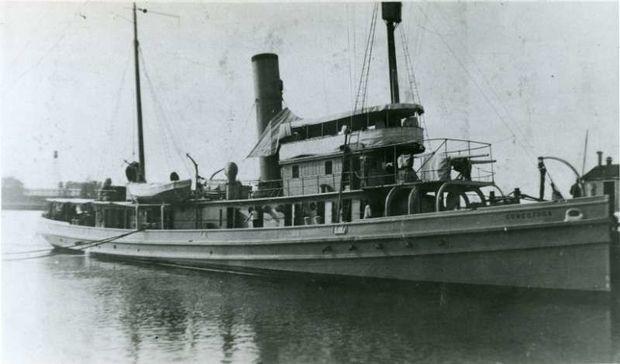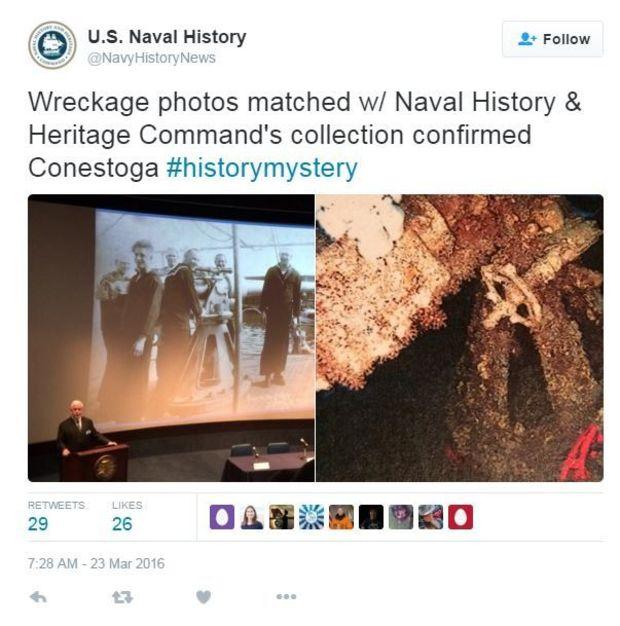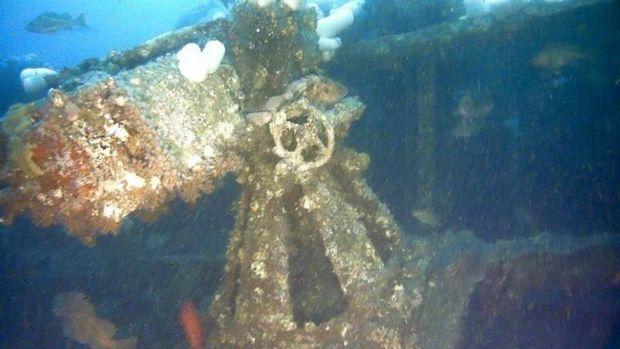In November 1903, the 170-foot
USS Conestoga was launched at the Sparrows Point Shipyard in Baltimore, MD. The steel tug was originally built to tow coal barges for the Philadelphia and Reading Railroad before it was purchased by the U.S. Navy in 1917. With the outbreak of World War I, the ship was to be assigned to the submarine force. A three-inch 50 caliber gun was mounted on the deck and the Conestoga began carrying out towing duties, transporting supplies, and escorting convoys throughout the Atlantic Ocean. By the end of the war she was reassigned to the Pacific.
On March 25, 1921, the tug departed from Mare Island in Vallejo, CA, en route to Pearl Harbor, Hawaii. The passage should have taken two weeks but when the
Conestoga failed to arrive, the Navy launched the largest air and sea search to date, scouring more than 300,000 square miles around Hawaii. By June 30, 1921, the ship and its 56 crew members were declared lost at sea.

But in a surprising twist of fate, the
USS Conestoga was just recently discovered about 30 miles from the mouth of the San Francisco Bay. In 2009, NOAA marine researchers were mapping the ocean floor in the Greater Farallones National Marine Sanctuary just off the coast when an unknown 170-foot wreck was detected on the seafloor. It did not match any known shipwreck off California. Then in September 2014, research robots captured video of the wreck and after scouring historical accounts of tugs that departed the Golden Gate and were never seen again, it was determined that the unidentified ship was in fact the
Conestoga. The ship was found almost 2000 miles from where it was presumed to have sunk.

After the identification of the wreck was made, family members of the lost crew were notified. On Wednesday, NOAA and the Navy officially announced the discovery in a special ceremony in Washington, DC, that included descendants of the
Conestoga crew. As of now, NOAA and the Navy investigation hypothesize that the tug was caught in a storm shortly after leaving California. It was a time of peace when the vessel disappeared without a trace. With the disappearance no longer a mystery, the hope is that families of the lost crew can finally have a measure of closure. Conestoga's final resting place in a National Marine Sanctuary is federally protected under the National Marine Sanctuaries Act and the Sunken Military Craft Act.

For videos of the discovery and to download the archaeological report, click to
sanctuaries.noaa.gov/conestoga/ But in a surprising twist of fate, the USS Conestoga was just recently discovered about 30 miles from the mouth of the San Francisco Bay. In 2009, NOAA marine researchers were mapping the ocean floor in the Greater Farallones National Marine Sanctuary just off the coast when an unknown 170-foot wreck was detected on the seafloor. It did not match any known shipwreck off California. Then in September 2014, research robots captured video of the wreck and after scouring historical accounts of tugs that departed the Golden Gate and were never seen again, it was determined that the unidentified ship was in fact the Conestoga. The ship was found almost 2000 miles from where it was presumed to have sunk.
But in a surprising twist of fate, the USS Conestoga was just recently discovered about 30 miles from the mouth of the San Francisco Bay. In 2009, NOAA marine researchers were mapping the ocean floor in the Greater Farallones National Marine Sanctuary just off the coast when an unknown 170-foot wreck was detected on the seafloor. It did not match any known shipwreck off California. Then in September 2014, research robots captured video of the wreck and after scouring historical accounts of tugs that departed the Golden Gate and were never seen again, it was determined that the unidentified ship was in fact the Conestoga. The ship was found almost 2000 miles from where it was presumed to have sunk.
 After the identification of the wreck was made, family members of the lost crew were notified. On Wednesday, NOAA and the Navy officially announced the discovery in a special ceremony in Washington, DC, that included descendants of the Conestoga crew. As of now, NOAA and the Navy investigation hypothesize that the tug was caught in a storm shortly after leaving California. It was a time of peace when the vessel disappeared without a trace. With the disappearance no longer a mystery, the hope is that families of the lost crew can finally have a measure of closure. Conestoga's final resting place in a National Marine Sanctuary is federally protected under the National Marine Sanctuaries Act and the Sunken Military Craft Act.
After the identification of the wreck was made, family members of the lost crew were notified. On Wednesday, NOAA and the Navy officially announced the discovery in a special ceremony in Washington, DC, that included descendants of the Conestoga crew. As of now, NOAA and the Navy investigation hypothesize that the tug was caught in a storm shortly after leaving California. It was a time of peace when the vessel disappeared without a trace. With the disappearance no longer a mystery, the hope is that families of the lost crew can finally have a measure of closure. Conestoga's final resting place in a National Marine Sanctuary is federally protected under the National Marine Sanctuaries Act and the Sunken Military Craft Act.
 For videos of the discovery and to download the archaeological report, click to sanctuaries.noaa.gov/conestoga/
For videos of the discovery and to download the archaeological report, click to sanctuaries.noaa.gov/conestoga/